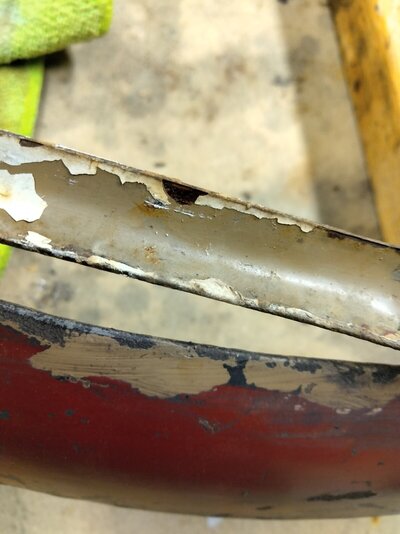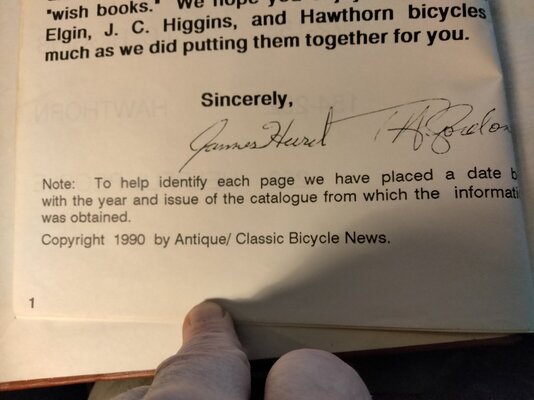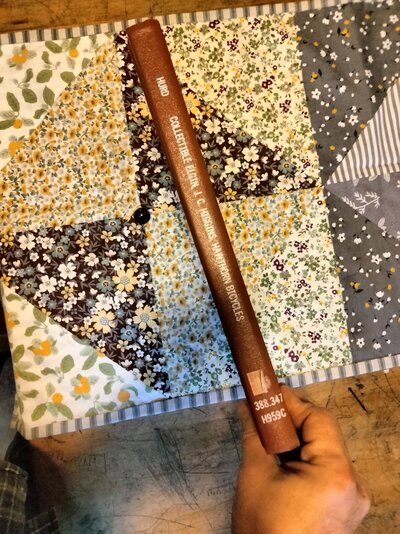You are using an out of date browser. It may not display this or other websites correctly.
You should upgrade or use an alternative browser.
You should upgrade or use an alternative browser.
When you click on links to various merchants on this site and make a purchase, this can result in this site earning a commission. Affiliate programs and affiliations include, but are not limited to, the eBay Partner Network.
Possible Elgin Victory found and what to do with it?
- Thread starter Uncle Shish
- Start date
Archie Sturmer
Riding a '38 Autocycle Deluxe
Nice bike; nice hardcover book.
Did you ever figure out if the bike was stamped “SE” (1940) or “SG” (1942)?
The “S” stamp with the date code on Murray bikes may be found on those Murray-built bikes sold by Sears, which just happens to start with the same letter “S”.
Did you ever figure out if the bike was stamped “SE” (1940) or “SG” (1942)?
The “S” stamp with the date code on Murray bikes may be found on those Murray-built bikes sold by Sears, which just happens to start with the same letter “S”.
Last edited:
DrRumack80
I live for the CABE
Nice! I had the softback version. Never knew there was a hardcover!
Uncle Shish
Finally riding a big boys bike
I am still not sure. I wonder though, if 1942 bikes were made from parts on hand, would they have had the serial code stamp of whatever year the frame was made?Nice bike; nice hardcover book.
Did you ever figure out if the bike was stamped “SE” (1940) or “SG” (1942)?
The “S” stamp with the date code on Murray bikes may be found on those Murray-built bikes sold by Sears, which just happens to start with the same letter “S”.
One thing I am convinced of now is the original color combo was maroon and tan. Beneath the black, and beneath another respray of red, and beneath the white - applied by brush, I found the clues of what was.
This photo shows the tan.
I found the maroon last night during disassembly but don't have a photo at this time.

Uncle Shish
Finally riding a big boys bike
Leon, I appreciate your knowledge. Do you know of any corresponding color charts that go with the catalog color destinations?Hello...
Forget the "books."
What you actually have is an Elgin war-restricted model. PERIOD. Not a Victory model... and this is not debatable. This history ought to be clear after all these years. But unfortunately it is anything but clear. The hobby and even the industry have hopelessly confused "war-restricted" with "Victory model". At least one brand of bicycles actually referred to its entire line of 1942 bicycles as "Victory" bicycles.
Here is what actually happened... and this is not an opinion, it is a fact.
• At the end of 1941 the federal War Board and other federal entities realized that transportation would be a critical issue during World War II. Therefore the federal government devised strict specifications by which bicycles could be made. The reason was to ensure continued manufacture, but with maximum savings on materials such as steel, brass, copper, aluminum and rubber. All of these materials would be in critical need by the military. Victory bicycles (built to the federal specification) would use the least of these materials possible.
Furthermore, with many workforce adults expected to be riding bicycles to manufacturing plants, etc. the plan was to make bicycles as light as possible and as devoid of things as horn tanks, lights, knee-action forks, rear carriers, fat tires, etc. So the Victory model specification meant lightweight diamond frames, skinny tires & wheels, basic coaster brake. In short, none of these were balloon-tire bicycles.
• The federal edict for Victory bicycles was sent to everyone in the bicycle industry and went into effect in the spring of 1942. National Bicycle History Archive of America, of course, has the full edict and related mailings today. IN the original mailers. Much of the special edict was published in American Bicyclist & Motorcyclist trade magazine at the time it was devised.
• Officially as of spring of 1942, only two bicycle manufacturers (Huffman and Westfield) were allowed to continue making bicycles. The bicycles made were of Victory specification. Manufacture of balloon models ceased except for those assembled out of parts that already existed as of spring of 1942 (yes, some companies stocked up parts in anticipation).
• Restrictions were very severe at the beginning of WW2 and were gradually eased during the course of the war. To buy a bicycle at all, one had to be engaged in work producing war materials or for government or military. A buyer needed to have a government-issued ration ticket that allowed purchase.
• Companies other than the two federally authorized were assigned war-related manufacturing projects and things would remain so for the extent of the war. NBHAA has original correspondence from various American bicycle companies such as Iver-Johnson, Colson, Murray-Ohio, Arnold, Schwinn & Co, Delta Electric and others indicating that they were engaged in making items for the war
• Using store mail-order catalogues as the standard of what was and was not sold is a blind alley and a very, very bad way of knowing what actually was sold. We have the in-store information used by management and even it has anomolies. Balloon tire bicycles shown in wartime mail-order catalogues like Sears, Roebuck or Montgomery Ward were mostly marketing department projections of what MIGHT be available. But what you could actually buy at the stores might be wildly different. With few exceptions, balloon models were only sold as long as parts existed. In the case of manufacturers like Arnold, Schwinn & Company (ASC), the images in their catalogues were largely stamped "No longer available" or some similar wording. ASC did get a limited authorization to assemble a limited number of Cycletrucks– primarily out of existing parts.
• There were certain balloon models made strictly for the military. These were made beginning in 1941 and some continued through the war. Some of the early balloon-tire models made for the military during 1941-1942 were made by Cleveland Welding Company (yes... NBHAA has original glossy photos).
Sears Elgin war-restricted models still had balloon tires. Some even had accessories. Our unmolested Murray-built Elgin original (see attachment below) has the electric tail light and horn. We have owned it since the beginning of the 1970s. Rather than a brass headbadge, our war-restricted Elgin has the name painted on.
Every few years, somebody walks out of the mists and invents yet another term. But originally (once upon a time long before the internet) it was clearly understood which was which.
So. In the USA from 1942 to 1945 there were actual Victory model bicycles... and war-restricted model bicycles. Two different things.
Leon Dixon
National Bicycle History Archive of America
(NBHAA.com)
View attachment 1935284
Examples Maroon 417 and Light Brown 121
Since the original paint isn't salvageable I'd like to match and repaint this as close as possible to original colors.
Also, if 1942 Elgin bikes were made from parts on hand, would they have had the serial code stamp of whatever year the frame was made?
Giraffe Rider
Finally riding a big boys bike
I got this Elgin in early 1980’s from original owner in Oakland Calif. Found matching ladies model a little later. Both Murray built. 1940 I believe. Both have the 4 stars on fork. Does the big V on head badge make it a Victory bike?


Uncle Shish
Finally riding a big boys bike
I think that's been answered in this thread ... now you're about to get us all reprimanded once again!I got this Elgin in early 1980’s from original owner in Oakland Calif. Found matching ladies model a little later. Both Murray built. 1940 I believe. Both have the 4 stars on fork. Does the big V on head badge make it a Victory bike?
View attachment 1935793
View attachment 1935794
Absolutely love that color combo!
NBHAA
National Bicycle History Archive of America
Duh-duh-duhhhhh. You are certainly in no position to state what I am saying. But it sure makes it difficult to learn anything new with your head stuck so deep in the sand! If you like it that way, fine. That's your business.So your saying the reprinted catalog pic are not out of a real Sears catalog?, looks the same as the "real 42 Sears catalog", I'd rather thumb thru the reprints and save damage/ware to the og, any pics of original would help all of us here but all I see is criticism Oh ya, any page # differences ( pages added ) in the Sears/Hawthorn catalog reprint book is due to it being Revised by "The Classic and Bicycle Exchange" ( The CABE! ) our host!
1.) I'm saying you don't know what you are reading. And whoever originally did these Xerox books was not an "author"... just a collator who also did not know what they were looking at any more than you do! The few facts that made it into the early editions (how many revisions of revisions have there been? Do YOU know?) did not come from a poser pretending to know. Each of these early editions poses as "factual"... So? All of this business is predicated on the notion that who ever wrote out the editorial lead-ins and posted dates on original literature actually KNEW what they were talking about. Just like when a grandiose (disastrous) CWC "1948 Roadmaster Luxury Liner" repop got released with a signed hang tag claiming it to be absolutely authentic...(it had the wrong tank and horn button; had chrome fenders instead of painted; had a chain guard logo from 1952; a seatpost tube graphic copied directly out of one of my 1950s catalogues; nightmarish electrical system nothing like original; and other bogus stuff. But some of you guys ate it up! Wow! It's signed authentic!!!!!
2.) It does not matter after all these years who is the latest revisor and the accuracy status TODAY. People have been lulled into thinking the originals were some kind of accurate bible for years. Right? What kind of BOOB would actually be so far off the mark that they could not ID catalogue pages they Xeroxed into a book?????
3. Early editions (there were several– no matter how they were bound... and there are PLENTY of libraries that do such things to paperback books)... provide the easy answer to question #2. Early additions were silly enough to tell you faithful "readers" and "believers" that the bicycle shown on PAGE 100 was in fact a J.C. Higgins 100. Wow. Of course at that time, the person telling you such silliness had never even SEEN a J.C. Higgins 100... only heard of mine! Don't take my word for it. DO YOUR HOMEWORK and prove your endless ridiculous argument. Go back and LOOK! Of course if your slick excuse for this obvious lie is that "pages were added" (blaah-blaah-blahhhh)... WHERE was the REAL J.C. Higgins `100' in ANY of those editions????? By your excuse, it should have appeared on a page somewhere, somehow. So? SHOW IT, arguer!
4.) All you "see" is "criticism"? Well. Then you don't see much then do you? If you choose to use the "source" you refer to as the be-all and end-all bible of J.C. Higgins, then you've already revealed the extent of your vision. And your knowledge. If this is all you know and all you want to know... it is certainly your choice to remain uninformed. Don't bother you with the facts because you've already got your mind made up, huh? Good job. Stick with that thinking and you'll go far. All I see is mindless arguing and not one iota of knowledge growth. Not one.
All this kind of infantile arguing is fine for a social club of juveniles... but it will get you absolutely nowhere.
NBHAA
National Bicycle History Archive of America
You asked... and this will be my last response on this matter since it has degenerated into yet one more infantile argument and insults so notorious on these troll havens.Leon, I appreciate your knowledge. Do you know of any corresponding color charts that go with the catalog color destinations?
Examples Maroon 417 and Light Brown 121
Since the original paint isn't salvageable I'd like to match and repaint this as close as possible to original colors.
Also, if 1942 Elgin bikes were made from parts on hand, would they have had the serial code stamp of whatever year the frame was made?
Here is yet another fact and not an infantile argument...
Regarding Elgin colors: As I have said more than once in my own publications, shows and writings MANY years ago, yes. Indeed there were color samples published. Anyone posting witty put-downs and retorts should have been able to tell you this fact here on the almighty CABE rather than posting silly arguments and insults.
All you need to do is get a Sears STORE catalogue (preferably a seasonal major city regional version). Then note the colors listed in the bicycle advertisement... then go to the paint section of said catalogue. In the larger seasonal, regional catalogues, color samples should be in this section. Match the numbers in the colors of the bicycles with the paint sample colors. Easy.
Of course, I have always, always said (and this means over 50 years) that matching paint is best done by a professional automotive paint supplier store. Have them match good original samples on your bicycle parts. A pro automotive paint supplier ought to be able to mix your paint fort you.
Personally, I used Betz Speed & Color in Southern California for many years. They did fabulous work. But I suspect so many years have gone by that they may not exist any more. But there are others out there.
Regarding 1942 Elgin serial numbers... Without getting into a very long discertation here, suffice to say this is a VERY complicated business. Serial number freaks will take you in endless circles here. And quote the same old tired stuff out of a Xeroxed Western Auto dealer advisory. No good for what you want to know. Parts did not have serial numbers... frames did. But almost no one who imagines they have mastered this info actually knows the facts. And this (again) leads to endless blind-leading-the-blind arguments.
Hope this helps,
Leon Dixon
National Bicycle History Archive of America
(NBHAA.com)
Similar threads
- Replies
- 0
- Views
- 366
- Replies
- 0
- Views
- 290
- Replies
- 0
- Views
- 89
- Replies
- 16
- Views
- 861




















